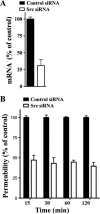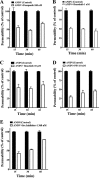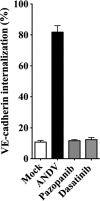VEGFR2 and Src kinase inhibitors suppress Andes virus-induced endothelial cell permeability
- PMID: 21177802
- PMCID: PMC3067787
- DOI: 10.1128/JVI.02319-10
VEGFR2 and Src kinase inhibitors suppress Andes virus-induced endothelial cell permeability
Abstract
Hantaviruses predominantly infect human endothelial cells and, in the absence of cell lysis, cause two diseases resulting from increased vascular permeability. Andes virus (ANDV) causes a highly lethal acute pulmonary edema termed hantavirus pulmonary syndrome (HPS). ANDV infection enhances the permeability of endothelial cells in response to vascular endothelial growth factor (VEGF) by increasing signaling responses directed by the VEGFR2-Src-VE-cadherin pathway, which directs adherens junction (AJ) disassembly. Here we demonstrate that inhibiting pathway-specific VEGFR2 and Src family kinases (SFKs) blocks ANDV-induced endothelial cell permeability. Small interfering RNA (siRNA) knockdown of Src within ANDV-infected endothelial cells resulted in an ∼70% decrease in endothelial cell permeability compared to that for siRNA controls. This finding suggested that existing FDA-approved small-molecule kinase inhibitors might similarly block ANDV-induced permeability. The VEGFR2 kinase inhibitor pazopanib as well as SFK inhibitors dasatinib, PP1, bosutinib, and Src inhibitor 1 dramatically inhibited ANDV-induced endothelial cell permeability. Consistent with their kinase-inhibitory concentrations, dasatinib, PP1, and pazopanib inhibited ANDV-induced permeability at 1, 10, and 100 nanomolar 50% inhibitory concentrations (IC(50)s), respectively. We further demonstrated that dasatinib and pazopanib blocked VE-cadherin dissociation from the AJs of ANDV-infected endothelial cells by >90%. These findings indicate that VEGFR2 and Src kinases are potential targets for therapeutically reducing ANDV-induced endothelial cell permeability and, as a result, capillary permeability during HPS. Since the functions of VEGFR2 and SFK inhibitors are already well defined and FDA approved for clinical use, these findings rationalize their therapeutic evaluation for efficacy in reducing HPS disease. Endothelial cell barrier functions are disrupted by a number of viruses that cause hemorrhagic, edematous, or neurologic disease, and as a result, our findings suggest that VEGFR2 and SFK inhibitors should be considered for regulating endothelial cell barrier functions altered by additional viral pathogens.
Figures




Similar articles
-
Andes virus regulation of cellular microRNAs contributes to hantavirus-induced endothelial cell permeability.J Virol. 2010 Nov;84(22):11929-36. doi: 10.1128/JVI.01658-10. Epub 2010 Sep 15. J Virol. 2010. PMID: 20844033 Free PMC article.
-
Pathogenic hantaviruses Andes virus and Hantaan virus induce adherens junction disassembly by directing vascular endothelial cadherin internalization in human endothelial cells.J Virol. 2010 Jul;84(14):7405-11. doi: 10.1128/JVI.00576-10. Epub 2010 May 12. J Virol. 2010. PMID: 20463083 Free PMC article.
-
Slit2-Robo4 receptor responses inhibit ANDV directed permeability of human lung microvascular endothelial cells.Antiviral Res. 2013 Aug;99(2):108-12. doi: 10.1016/j.antiviral.2013.05.004. Epub 2013 May 20. Antiviral Res. 2013. PMID: 23702092 Free PMC article.
-
Hantavirus pulmonary syndrome.Virus Res. 2011 Dec;162(1-2):138-47. doi: 10.1016/j.virusres.2011.09.017. Epub 2011 Sep 17. Virus Res. 2011. PMID: 21945215 Review.
-
Hantavirus regulation of endothelial cell functions.Thromb Haemost. 2009 Dec;102(6):1030-41. doi: 10.1160/TH09-09-0640. Thromb Haemost. 2009. PMID: 19967132 Review.
Cited by
-
Hantavirus: an overview and advancements in therapeutic approaches for infection.Front Microbiol. 2023 Oct 12;14:1233433. doi: 10.3389/fmicb.2023.1233433. eCollection 2023. Front Microbiol. 2023. PMID: 37901807 Free PMC article. Review.
-
T cells are not required for pathogenesis in the Syrian hamster model of hantavirus pulmonary syndrome.J Virol. 2011 Oct;85(19):9929-44. doi: 10.1128/JVI.05356-11. Epub 2011 Jul 20. J Virol. 2011. PMID: 21775442 Free PMC article.
-
Hantavirus interferon regulation and virulence determinants.Virus Res. 2014 Jul 17;187:65-71. doi: 10.1016/j.virusres.2013.12.041. Epub 2014 Jan 8. Virus Res. 2014. PMID: 24412542 Free PMC article.
-
Endothelial FAK as a therapeutic target in disease.Microvasc Res. 2012 Jan;83(1):89-96. doi: 10.1016/j.mvr.2011.09.011. Epub 2011 Oct 6. Microvasc Res. 2012. PMID: 22008516 Free PMC article. Review.
-
The kidney in hantavirus infection-epidemiology, virology, pathophysiology, clinical presentation, diagnosis and management.Clin Kidney J. 2022 Jan 29;15(7):1231-1252. doi: 10.1093/ckj/sfac008. eCollection 2022 Jul. Clin Kidney J. 2022. PMID: 35756741 Free PMC article. Review.
References
-
- Adjei, A. A. 2007. Novel small-molecule inhibitors of the vascular endothelial growth factor receptor. Clin. Lung Cancer 8(Suppl. 2):S74-S78. - PubMed
-
- Berger, M. M., et al. 2005. Hypoxia impairs systemic endothelial function in individuals prone to high-altitude pulmonary edema. Am. J. Respir. Crit. Care Med. 172:763-767. - PubMed
Publication types
MeSH terms
Substances
Grants and funding
LinkOut - more resources
Full Text Sources
Other Literature Sources
Miscellaneous

